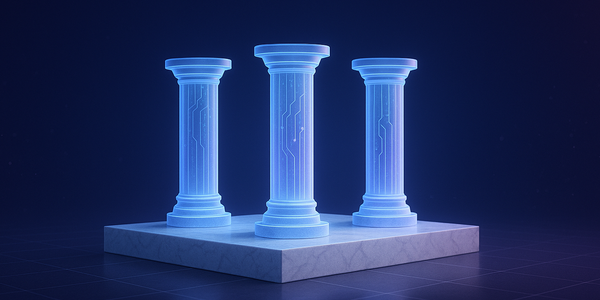AI-Enhanced Development Process

Smart executives are restructuring their product teams around AI and seeing 3x faster delivery. Here's exactly how they're doing it.
Every technology leader faces the same resource constraint: great engineers are expensive and hard to find. While competitors scramble to hire more developers, forward-thinking executives are discovering something counterintuitive: AI doesn't just help you build better products, it fundamentally multiplies what your existing team can accomplish.
The companies implementing this correctly are shipping features 3x faster with the same headcount. Through my experience as both a CTO and consultant, the pattern is clear: success isn't about better tools, it's about restructuring your entire product development process around AI's strengths.
The Traditional Product Development Bottleneck
Before diving into AI solutions, let's identify where the biggest inefficiencies hide in typical product development.
The Standard Process (and Its Problems):
- Ideation: Product managers spend weeks in whiteboards and meetings, often building concepts that engineering later deems impossible
- Design: UX teams create wireframes and mockups, usually disconnected from technical constraints
- Requirements: Converting ideas into detailed user stories takes days of back-and-forth between teams
- Development: Engineers finally start coding, often discovering the original concept needs major changes
- Testing: QA finds issues that require going back to step 3 or 4
- Documentation: Teams scramble to document what was actually built (if they document at all)
The hidden cost: Most feature requests die somewhere between steps 1-4, wasting months of expensive talent time.
What I consistently see: Teams spending weeks on requirements and design before engineering can provide realistic estimates, with many initial concepts never making it to production.
How AI Transforms Each Stage
Smart teams are using AI to collapse these bottlenecks and eliminate waste. Here's the stage-by-stage breakdown:
1. Ideation & Proof of Concepts
Old way: Product managers pitch concepts, engineers estimate "8-12 weeks," idea gets shelved.
AI-powered way: Product managers build functional prototypes in hours, not months.
Real transformation: A fintech PM used AI to prototype a fraud detection dashboard in 2 hours, complete with mock data, interactive charts, and user flows. The engineering team could immediately see feasibility and provide accurate time estimates. The feature shipped 6 weeks ahead of schedule.
Business impact: Features that would never get prioritized due to "unknown complexity" now get built because the risks are visible upfront.
2. Design & User Experience
Old way: Designers create beautiful mockups that engineers can't implement within budget constraints.
AI-powered way: Initial wireframes and component code generated automatically, then refined by human designers.
How it works: AI tools turn text prompts like "customer dashboard with filtering and export options" into working wireframes. Designers spend time perfecting the user experience instead of drawing boxes and buttons.
Critical insight: Final design quality still requires human expertise, but AI eliminates 70% of the initial grunt work.
3. Requirements & User Stories
Old way: Converting product concepts into detailed engineering requirements takes days of meetings and documentation.
AI-powered way: AI assistants analyze product requirements documents, user interviews, or Figma designs to generate complete user stories with acceptance criteria.
Real transformation: What used to take a week of backlog grooming now happens in 30 minutes. Teams spend their time refining priorities instead of writing basic documentation.
4. Development & Coding
Old way: Engineers spend 60% of their time on repetitive coding tasks, 40% on complex problem-solving.
AI-powered way: AI handles the repetitive work, engineers focus entirely on architecture and complex logic.
The multiplier effect: Your senior engineers become 2-3x more productive because they're not writing boilerplate code, fixing syntax errors, or searching Stack Overflow for common patterns.
Important: This isn't about replacing engineers, it's about freeing them to work on the problems only humans can solve.
5. Testing & Quality Assurance
AI enhancement: Automated test case generation from user stories, intelligent bug triage, and predictive quality scoring.
Business benefit: Catch issues earlier in the process when they're cheaper to fix, and reduce the time between feature completion and customer delivery.
6. Documentation & Knowledge Management
Old reality: Most teams ship features with minimal documentation, creating technical debt and onboarding challenges.
AI solution: Auto-generate documentation from code, user stories, and design files. Keep it current automatically as features evolve.
Strategic advantage: Your team knowledge becomes searchable and transferable, reducing bus-factor risk and speeding up new team member onboarding.
Why This Matters Right Now
Economic reality: The companies mastering this approach will build competitive moats while others struggle with resource constraints.
Competitive timing: AI development tools are still early. Teams that implement these processes now gain 12-18 months of advantage before they become standard practice.
Risk mitigation: Rather than betting your company on hiring more expensive engineers, you multiply the capacity of your existing team, a much more controllable strategy.
The Implementation Reality
This transformation doesn't happen overnight. Success requires:
- Process redesign: Your current workflows must evolve (just like adopting Agile 20 years ago)
- Tool selection: The AI landscape changes monthly; picking the right tools requires expertise
- Team training: Your people need to learn new skills and work patterns
- Quality control: AI output needs human oversight to maintain standards
The bottom line: Companies that approach this strategically see dramatic results. Those who experiment randomly waste time and money.
Your 90-Day Implementation Plan
Month 1: Foundation
- Audit current bottlenecks in your product development process
- Pilot AI assistance in one stage (ideation, design, or coding)
- Establish baseline metrics for time-to-delivery and quality
Month 2: Scale
- Expand AI tools to 2-3 additional development stages
- Train team members on new workflows and tools
- Measure productivity improvements and iterate
Month 3: Optimize
- Implement AI across the full development lifecycle
- Establish quality control processes for AI-generated work
- Document new processes and best practices for scaling
The Bottom Line
AI-enhanced development isn't just about productivity—it's about competitive advantage. While your competitors debate AI strategy, your team could be shipping features at 3x the speed.
The teams winning in AI development don't have better models or fancier tools. They have better processes, clearer measurement, and systematic approaches to integrating AI into their existing workflows.
The key metric isn't features shipped—it's capacity multiplied. Teams that can build more with the same resources will dominate their markets.
Ready to multiply your team's development capacity?
If you'd like an outside perspective to audit your current development process and identify the highest-impact opportunities for AI integration, let's discuss your specific situation.


